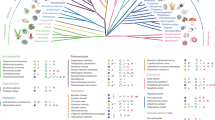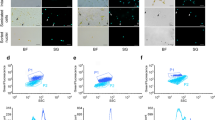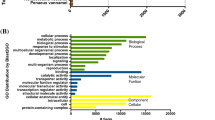Abstract
Among marine invertebrates, the starlet sea anemone Nematostella vectensis has emerged as an important laboratory model system. One advantage of working with this species relative to many other marine invertebrates is the ease of isolating relatively pure DNA, RNA and protein. Nematostella can be raised at high densities, under clean culture conditions, and it lacks integumentary or skeletal structures that can impede the recovery of DNA, RNA or protein. Here we describe methods used in our lab to isolate DNA, RNA and protein from Nematostella embryos, larvae and adults. The methods described here are less expensive than commercial kits and are more easily scalable to larger tissue amounts. Preparation of DNA can be completed in ∼7 h, RNA preparation in ∼1.5 h and protein preparation in ∼1 h.
This is a preview of subscription content, access via your institution
Access options
Subscribe to this journal
Receive 12 print issues and online access
$259.00 per year
only $21.58 per issue
Buy this article
- Purchase on Springer Link
- Instant access to full article PDF
Prices may be subject to local taxes which are calculated during checkout



Similar content being viewed by others
References
Reitzel, A.M., Ryan, J.F. & Tarrant, A.M. Establishing a model organism: a report from the first annual Nematostella meeting. Bioessays 34, 158–161 (2012).
Darling, J.A. et al. Rising starlet: the starlet sea anemone, Nematostella vectensis. Bioessays 27, 211–221 (2005).
Stefanik, D.S., Friedman, L. & Finnerty, J.R. Collecting, rearing, spawning, and inducing regeneration of the starlet sea anemone, Nematostella vectensis. Nat. Protoc. 8, 916–923 (2013).
Finnerty, J.R. & Martindale, M.Q. Homeoboxes in sea anemones (Cnidaria:Anthozoa): a PCR-based survey of Nematostella vectensis and Metridium senile. Biol. Bull. 193, 62–76 (1997).
Wolenski, F.S. et al. Characterization of the core elements of the NF-κB signaling pathway of the sea anemone Nematostella vectensis. Mol. Cell Biol. 31, 1076–1087 (2011).
Finnerty, J.R., Paulson, D., Burton, P., Pang, K. & Martindale, M.Q. Early evolution of a homeobox gene: the parahox gene Gsx in the Cnidaria and the Bilateria. Evol. Dev. 5, 331–345 (2003).
Reitzel, A.M., Sullivan, J.C. & Finnerty, J.R. Qualitative shift to indirect development in the parasitic sea anemone Edwardsiella lineata. Integr. Comp. Biol. 46, 827–837 (2006).
Blin, N. & Stafford, D.W. A general method for isolation of high molecular weight DNA from eukaryotes. Nucleic Acids Res. 3, 2303–2308 (1976).
Sambrook, J., Fritsch, E.F. & Maniatis, T. Molecular Cloning. A Laboratory Manual 2nd edn. (Cold Spring Harbor Laboratory, 1989).
Chomczynski, P. & Sacchi, N. The single-step method of RNA isolation by acid guanidinium thiocyanate-phenol-chloroform extraction: twenty-something years on. Nat. Protoc. 1, 581–585 (2006).
Wolenski, F.S. et al. Two polymorphic residues account for the differences in DNA binding and transcriptional activation by NF-κB proteins encoded by naturally occurring alleles in Nematostella vectensis. J. Mol. Evol. 73, 325–336 (2011).
Sullivan, J.C. et al. Two alleles of NF-κB in the sea anemone Nematostella vectensis are widely dispersed in nature and encode proteins with distinct activities. PLoS ONE 4, e7311 (2009).
Carle, G.F. & Carle, G.F. Field-inversion gel electrophoresis. Methods Mol. Biol. 12, 3–18 (1992).
Acknowledgements
This research was supported by the National Science Foundation grant MCB-0924749 (T.D.G. and J.R.F.). D.J.S. was supported by a Predoctoral Fellowship Award to Promote Diversity in Health-Related Research from the US National Institutes of Health (F31 GM095289-01). F.S.W. was supported by a predoctoral grant from the Superfund Basic Research Program at Boston University (5 P42 E507381). D.J.S. and F.S.W. were also supported by Warren-McLeod graduate fellowships in Marine Biology.
Author information
Authors and Affiliations
Contributions
The extraction protocols were optimized as follows: DNA (J.R.F., L.E.F.); RNA (D.J.S.); and protein (F.S.W.). T.D.G. and J.R.F. supervised the development of the protocols. All authors participated in writing the manuscript.
Corresponding author
Ethics declarations
Competing interests
The authors declare no competing financial interests.
Rights and permissions
About this article
Cite this article
Stefanik, D., Wolenski, F., Friedman, L. et al. Isolation of DNA, RNA and protein from the starlet sea anemone Nematostella vectensis. Nat Protoc 8, 892–899 (2013). https://doi.org/10.1038/nprot.2012.151
Published:
Issue Date:
DOI: https://doi.org/10.1038/nprot.2012.151
This article is cited by
-
Involvement of the ammonium assimilation mediated by glutamate dehydrogenase in response to heat stress in the scleractinian coral Pocillopora damicornis
Journal of Oceanology and Limnology (2022)
-
Polymorphism in the symmetries of gastric pouch arrangements in the sea anemone D. lineata
Zoological Letters (2021)
-
Possible roles of glutamine synthetase in responding to environmental changes in a scleractinian coral
Molecular Biology Reports (2018)
-
Transcriptome, expression, and activity analyses reveal a vital heat shock protein 70 in the stress response of stony coral Pocillopora damicornis
Cell Stress and Chaperones (2018)
-
A transcriptional time-course analysis of oral vs. aboral whole-body regeneration in the Sea anemone Nematostella vectensis
BMC Genomics (2016)
Comments
By submitting a comment you agree to abide by our Terms and Community Guidelines. If you find something abusive or that does not comply with our terms or guidelines please flag it as inappropriate.



